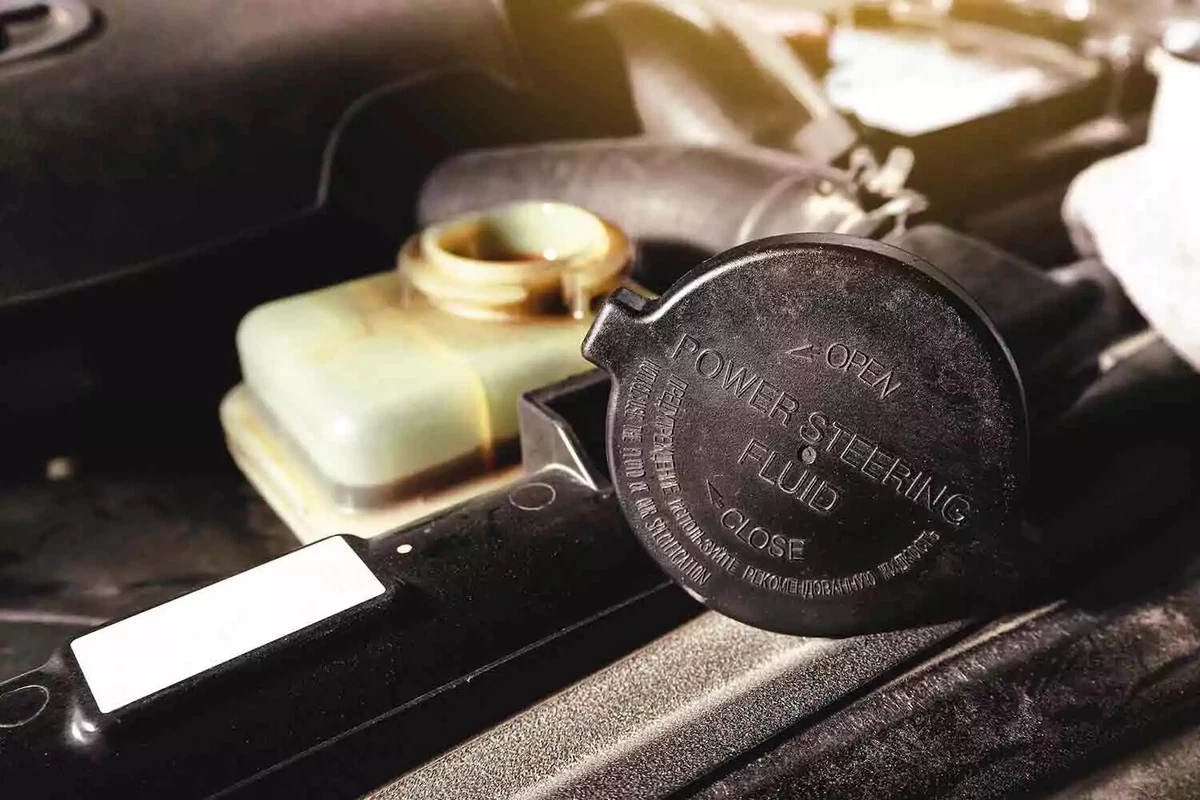
The power steering fluid reservoir is easy to locate under the hood.
If your steering is starting to feel sluggish or off, it may be time to flush the power steering fluid. This article explores the basics of power steering fluid, including warning signs that the power steering fluid needs to be changed.
When it’s time to do the job, follow our step-by-step how-to article and video. It has instructions for getting the job done at home.
How Power Steering Fluid Works

Steering was a chore prior to the introduction of power steering seven decades ago. This unit was designed for a mid-1950s Chevrolet passenger vehicle.
Hydraulic power steering debuted in the 1950s. For the following decades, it was mostly available on luxury vehicles. Older trucks and vintage cars don’t have power steering.
Most cars and trucks on the road today use hydraulic power steering. As a result, they require fresh power steering fluid to run a power steering pump. The pump pressurizes hydraulic fluid that flows as you turn the wheel, making it easier to steer the vehicle. The hydraulic steering system also lubricates the power steering pump and related components.
Power steering pumps run at high pressure, around 2,000 psi. That requires clean fluid—the cleaner, the better.
Steering fluid is essentially the same hydraulic fluid as automatic transmission fluid. Various formulations use detergents and additives to handle different operating temps and functions. It depends on the vehicle manufacturer. In fact, using the wrong fluid could void your warranty.
With the rise of hybrids and advanced vehicle electronics since the 2000s, automakers switched to electronic power steering. Instead of a hydraulic pump, these systems use electric motors to assist the steering wheel. They don’t use fluid for this task.
How long does power steering fluid last?
As with any automotive fluid, power steering fluid breaks down over time. It becomes old and filled with contaminants. Manufacturers specify a change interval of every 30,000 to 50,000 miles or three to five years. Check your owner’s manual for details related to your vehicle.
Signs of Dirty Power Steering Fluid
When the fluid needs to be changed, you may hear squealing or groaning coming from the pump. The steering may also become heavier.
A quick look at the fluid should reveal its condition. You might notice foam in the steering fluid reservoir. Your car might use red or green power steering fluid. Regardless, it should be clear on the dipstick. If it is difficult to see through or turned brown/black, it’s time to change it.
The fluid should smell good. Most people describe the smell as oily and slightly sweet. If it is old, it smells burned. If you are unsure, open a new bottle to compare it with your current power steering fluid.
How long can you drive with dirty power steering fluid?
Driving with dirty fluid could damage sensitive steering components. The contaminants in the fluid cause increased wear and tear, sluggish and stiff steering, and noise while driving. Over time, it could cause the power steering pump to fail, which is expensive to repair.
Flush and Replace Power Steering Fluid

Make sure that you have enough power steering fluid on hand before draining the system.
You’ll need to drain the system of all the fluid, flush it with fresh fluid, and drain it again before refilling it.
Whenever you work with automotive fluids, it’s essential to dispose of them properly. Power steering fluid is hazardous and can harm the environment. Bring old power steering fluid to a local recycling center or auto shop certified to dispose of hazardous material.
How much does it cost to flush your power steering fluid?
Expect to spend between about $20 and $40 per quart of power steering fluid, depending on your vehicle type. You may need one to two quarts. Check your owner’s manual for specifications. Not all power steering fluid is compatible.
Aside from the new fluid, you’ll need basic tools to get the job done. To get started, gather or buy a floor jack, jack stands, and a drain pan.
A professional power steering fluid flush could cost about $90 to $150, plus the marked-up cost of the fluid.
Replacing Related Parts

If the power steering pump is noisy, it might be due for replacement. This unit fits 1996-2000 Honda Civics.
While performing maintenance on the power steering system, it’s good to check hoses for leaks and wear. While you have the system empty, replace the hoses if you see any signs that they are leaking. The same is true with seals. We recommend replacing those parts while the system is empty.
We also suggest inspecting the vital power steering components. For example, you want to check the power steering pump, especially if you’ve been hearing whining or groaning. The symptoms of a bad power steering pump usually mimic those of contaminated fluid. Also, inspect the power steering rack-and-pinion (or steering gearbox) and the drive belt.
Share your feedback
This article is meant to provide general guidance only. Automotive maintenance, repair, upgrade, and installation may depend on vehicle-specifics such as make and model. Always consult your owner's manual, repair guide for specific information for your particular vehicle and consider a licensed auto-care professional's help as well, particularly for advance repairs.

















